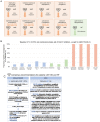Cardiovascular outcomes trials: a paradigm shift in the current management of type 2 diabetes
- PMID: 35927730
- PMCID: PMC9351217
- DOI: 10.1186/s12933-022-01575-9
Cardiovascular outcomes trials: a paradigm shift in the current management of type 2 diabetes
Abstract
Cardiovascular disease (CVD) is the leading cause of mortality and morbidity in patients with type 2 diabetes (T2D). Historical concerns about cardiovascular (CV) risks associated with certain glucose-lowering medications gave rise to the introduction of cardiovascular outcomes trials (CVOTs). Initially implemented to help monitor the CV safety of glucose-lowering drugs in patients with T2D, who either had established CVD or were at high risk of CVD, data that emerged from some of these trials started to show benefits. Alongside the anticipated CV safety of many of these agents, evidence for certain sodium-glucose transporter 2 (SGLT2) inhibitors and glucagon-like peptide-1 receptor agonists (GLP-1 RAs) have revealed potential cardioprotective effects in patients with T2D who are at high risk of CVD events. Reductions in 3-point major adverse CV events (3P-MACE) and CV death have been noted in some of these CVOTs, with additional benefits including reduced risks of hospitalisation for heart failure, progression of renal disease, and all-cause mortality. These new data are leading to a paradigm shift in the current management of T2D, with international guidelines now prioritising SGLT2 inhibitors and/or GLP-1 RAs in certain patient populations. However, clinicians are faced with a large volume of CVOT data when seeking to use this evidence base to bring opportunities to improve CV, heart failure and renal outcomes, and even reduce mortality, in their patients with T2D. The aim of this review is to provide an in-depth summary of CVOT data-crystallising the key findings, from safety to efficacy-and to offer a practical perspective for physicians. Finally, we discuss the next steps for the post-CVOT era, with ongoing studies that may further transform clinical practice and improve outcomes for people with T2D, heart failure or renal disease.
Keywords: CVOTs; Cardiovascular disease; Cardiovascular outcomes trials; Cardiovascular safety; Chronic kidney disease; GLP-1 RAs; Glucose-lowering drug; Heart failure; SGLT2 inhibitors; Type 2 diabetes.
© 2022. The Author(s).
Conflict of interest statement
MJD reported board membership and consultancy fees from Novo Nordisk, Sanofi-Aventis, Lilly, Merck, Sharp & Dohme, Boehringer Ingelheim, AstraZeneca, Servier, and Janssen. MJD reported institutional grants from Novo Nordisk, Sanofi-Aventis, Lilly, Boehringer Ingelheim and Janssen. MJD reported payment for lectures or speaker bureaus from Novo Nordisk, Sanofi-Aventis, Lilly, Merck, Sharp & Dohme, Boehringer Ingelheim, AstraZeneca, Janssen, Mitsubishi Tanabe Pharma, and Takeda Pharmaceuticals International.
HD declares no conflicts of interest.
FRJ has received consulting honoraria from Boehringer Ingelheim, Mundipharma, Astra Zeneca, Novo Nordisk, MSD, Lilly, and Sanofi.DKM has had leadership roles in clinical trials for AstraZeneca, Boehringer Ingelheim, Eisai, Esperion, GlaxoSmithKline, Janssen, Lexicon, Merck & Co., Inc., Novo Nordisk, CSL Behring, and Sanofi USA; and has received consultancy fees from AstraZeneca, Boehringer Ingelheim, Lilly USA, Merck & Co., Inc., Pfizer, Novo Nordisk, Metavant, Afimmune, and Sanofi.
ZP has received consulting honoraria from Boehringer Ingelheim, Novo Nordisk, and Sanofi.
PMS has received honorarium for lectures for Medtronic, Abbott, Servier, Astra Zeneca, and Respicardia; Boehringer Ingelheim consultancy agreement and honorarium for lecture, Novartis consultancy agreement and honorarium for lecture, Vifor Pharma consultancy agreement.
CW has received personal fees from Boehringer Ingelheim, Akebia, AstraZeneca, Bayer, Eli Lilly, GlaxoSmithKline, Gilead, Merck Sharpe Dohme, Mundipharma, Sanofi-Genzyme, and Vifor Fresenius.
Figures







Similar articles
-
Review of cardiovascular outcomes trials of sodium-glucose cotransporter-2 inhibitors and glucagon-like peptide-1 receptor agonists.Curr Opin Cardiol. 2019 Nov;34(6):687-692. doi: 10.1097/HCO.0000000000000673. Curr Opin Cardiol. 2019. PMID: 31436559 Free PMC article. Review.
-
Cardiovascular safety outcomes of once-weekly GLP-1 receptor agonists in people with type 2 diabetes.J Clin Pharm Ther. 2020 Sep;45 Suppl 1(Suppl 1):61-72. doi: 10.1111/jcpt.13226. J Clin Pharm Ther. 2020. PMID: 32910492 Free PMC article. Review.
-
Real-world characteristics, modern antidiabetic treatment patterns, and comorbidities of patients with type 2 diabetes in central and Eastern Europe: retrospective cross-sectional and longitudinal evaluations in the CORDIALLY® study.Cardiovasc Diabetol. 2022 Oct 8;21(1):203. doi: 10.1186/s12933-022-01631-4. Cardiovasc Diabetol. 2022. PMID: 36209118 Free PMC article.
-
Navigating the "MACE" in Cardiovascular Outcomes Trials and decoding the relevance of Atherosclerotic Cardiovascular Disease benefits versus Heart Failure benefits.Diabetes Obes Metab. 2019 Aug;21(8):1780-1789. doi: 10.1111/dom.13740. Epub 2019 Apr 29. Diabetes Obes Metab. 2019. PMID: 30957945 Review.
-
Blood pressure-lowering effects of SGLT2 inhibitors and GLP-1 receptor agonists for preventing of cardiovascular events and death in type 2 diabetes: a systematic review and meta-analysis.Acta Diabetol. 2023 Dec;60(12):1651-1662. doi: 10.1007/s00592-023-02154-4. Epub 2023 Jul 13. Acta Diabetol. 2023. PMID: 37439858
Cited by
-
Dopamine in the Regulation of Glucose Homeostasis, Pathogenesis of Type 2 Diabetes, and Chronic Conditions of Impaired Dopamine Activity/Metabolism: Implication for Pathophysiological and Therapeutic Purposes.Biomedicines. 2023 Nov 7;11(11):2993. doi: 10.3390/biomedicines11112993. Biomedicines. 2023. PMID: 38001993 Free PMC article. Review.
-
The diabetes cardiovascular outcomes trials and racial and ethnic minority enrollment: impact, barriers, and potential solutions.Front Public Health. 2024 Oct 25;12:1412874. doi: 10.3389/fpubh.2024.1412874. eCollection 2024. Front Public Health. 2024. PMID: 39525461 Free PMC article. Review.
-
Different Associations between Lipid Levels and Risk for Heart Failure according to Diabetes Progression.Diabetes Metab J. 2025 Jan;49(1):105-116. doi: 10.4093/dmj.2024.0066. Epub 2024 Aug 28. Diabetes Metab J. 2025. PMID: 39197833 Free PMC article.
-
Study Design and Protocol for a Randomized Controlled Trial of Enavogliflozin to Evaluate Cardiorenal Outcomes in Type 2 Diabetes (ENVELOP).Diabetes Metab J. 2025 Mar;49(2):225-234. doi: 10.4093/dmj.2024.0238. Epub 2025 Jan 6. Diabetes Metab J. 2025. PMID: 39756817 Free PMC article.
-
Glucagon-like Peptide-1 Receptor Agonists and Diabetic Kidney Disease: From Bench to Bed-Side.J Clin Med. 2024 Dec 18;13(24):7732. doi: 10.3390/jcm13247732. J Clin Med. 2024. PMID: 39768655 Free PMC article. Review.
References
-
- Nwaneri C, Cooper H, Bowen-Jones D. Mortality in type 2 diabetes mellitus: magnitude of the evidence from a systematic review and meta-analysis. Br J Diabetes Vasc Dis. 2013;13:192–207. doi: 10.1177/1474651413495703. - DOI
Publication types
MeSH terms
Substances
LinkOut - more resources
Full Text Sources
Medical

